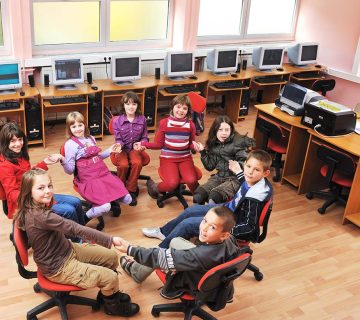Traveling with children by car or airplane can be both exciting and challenging. Keeping a child engaged during long hours of travel, preventing boredom, and creating a fun environment requires parents to prepare a variety of games and activities. Travel games not only make the journey feel shorter for kids but also enhance their cognitive skills, creativity, and family bonding. In this article, we first discuss the importance of keeping children entertained on the road, then introduce a collection of suitable games for both car and plane travel, and finally provide practical tips for preparing and executing these activities without stress.
1. The Importance of Travel Games for Children
1.1. Reducing Stress and Fatigue
Long trips can quickly exhaust children who must stare out a window or remain seated for extended periods. Short, varied games help:
-
Distraction: Focusing their attention on the game reduces complaints of discomfort.
-
Stress Reduction: New activities ease travel anxiety, especially for sensitive children in unfamiliar settings.
1.2. Enhancing Cognitive and Social Skills
Games that require thinking, memory, or verbal interaction not only entertain but also develop mental abilities:
-
Creativity and Problem Solving: Word-guessing games, collaborative storytelling, and simple puzzles boost creativity and critical thinking.
-
Vocabulary and Language Development: Games involving word puzzles or phrase construction expand the child’s vocabulary and speaking skills.
-
Listening and Group Participation: Some games require careful listening to rules or taking turns, strengthening social and auditory skills.
1.3. Creating Family Interaction
Travel games foster interaction and build shared memories among family members:
-
Strengthening Emotional Bonds: Families create joyful moments when parents, children, and siblings play together.
-
Open Communication: While playing, families can discuss travel experiences or other engaging topics, fostering closer connections.
-
Cross-Generational Engagement: Games can be suitable for extended families (e.g., grandparents joining in), involving multiple age groups.
2. Games and Activities for the Car
2.1. “Guess What?”
Game Description: One player thinks of an object, animal, or character and gives only broad clues. Others ask yes/no questions (e.g., “Is it alive?” “Is it found in the house?”) to guess what it is.
-
Benefits:
-
Boosts questioning skills and logical reasoning.
-
Increases listening attention and group participation.
-
-
How to Play:
-
A parent or older child chooses an item.
-
Other players take turns asking yes/no questions until someone guesses.
-
The first correct guesser picks the next item.
-
2.2. Simple Travel Crossword
Game Description: A pre-drawn crossword grid featuring easy travel-related words (e.g., “car,” “plane,” “bag,” “seat”).
-
Benefits:
-
Develops vocabulary and problem-solving skills.
-
Suitable for children aged 7 and up.
-
-
How to Play:
-
Parents prepare the crossword beforehand with definitions (e.g., “A vehicle with wings”).
-
The child fills in the grid based on the clues.
-
Correct answers reveal other intersecting words.
-
2.3. Travel Snacks List
Game Description: Each person names several foods starting with a given letter (e.g., “A: Apple, Apricot, Almonds…”).
-
Benefits:
-
Improves quick thinking and expands food-related vocabulary.
-
Works well on long trips with few breaks.
-
-
How to Play:
-
A parent or child chooses a letter (e.g., “S”).
-
Everyone must list two or three foods starting with that letter within 30 seconds.
-
A new letter is chosen, and the game continues.
-
2.4. “I Spy”
Game Description: One player says, “I spy something that starts with the letter…” and everyone guesses the object by looking around (car interior or through the window).
-
Benefits:
-
Enhances observation skills and awareness of the outside environment.
-
Great for city driving or scenic routes.
-
-
How to Play:
-
The chosen player announces a letter (e.g., “I spy something with ‘M’”).
-
Everyone looks out to identify an object that matches.
-
The first correct guesser picks the next letter.
-
2.5. Round-Robin Storytelling
Game Description: Players create a story together by adding one sentence at a time.
-
Benefits:
-
Stimulates verbal creativity and storytelling skills.
-
Encourages collaboration and empathy.
-
-
How to Play:
-
One person starts with a sentence (e.g., “Once upon a time in a small village…”).
-
The next person adds another sentence (“…there was a boy who loved adventures.”).
-
This continues until a short story forms.
-
3. Games and Activities for the Airplane
3.1. Portable Coloring Book
Activity Description: A small coloring book with washable markers or crayons.
-
Benefits:
-
Enhances fine motor skills and creativity.
-
Suitable for ages 3–10.
-
-
Tip: Choose thin pads and washable markers to save space and avoid mess.
3.2. Picture Puzzles
Activity Description: A booklet or printed sheets containing visual puzzles such as “spot the difference” or simple mazes.
-
Benefits:
-
Challenges problem-solving and visual acuity.
-
Ideal for children aged 6 and above.
-
-
How to Use:
-
Parents read the puzzle instructions aloud.
-
The child solves each puzzle, and parents review answers together.
-
3.3. Flashcards
Game Description: Flashcards with images of animals, colors, numbers, or letters.
-
Benefits:
-
Improves memory and introduces new vocabulary.
-
Takes up minimal space—easy to store in a carry-on.
-
-
How to Play:
-
Show a card and say the image’s name.
-
Ask the child to identify sounds (e.g., “What sound does a dog make?”) or form simple words.
-
3.4. Magnetic Puzzle/Board
Game Description: Simple magnetic pieces (animals, numbers, letters) on a small magnetic board.
-
Benefits:
-
No worry about pieces scattering on the floor in-flight.
-
Strengthens hand-eye coordination and shape recognition.
-
-
How to Play:
-
Parents or the child follow a small diagram to place magnetic pieces.
-
After completing a picture, dismantle and start again for more practice.
-
3.5. Quiet Verbal Games
Game Description: Low-volume or whispered word games (e.g., “I Spy,” “Guess the Cartoon Character”).
-
Benefits:
-
Respects cabin etiquette and rules.
-
Reinforces language skills and quiet focus.
-
-
How to Play:
-
A player thinks of a target (object or cartoon character).
-
Others guess with yes/no questions or word guesses in a hushed tone.
-
Moves silently and uses minimal gestures for clues.
-
4. Practical Tips for Preparation and Execution
4.1. Assemble a Dedicated Entertainment Kit
-
Small Bag or Ziplock Pouch: To store coloring books, flashcards, puzzle pages, and washable markers.
-
Limited Items: Packing 3–4 activity types prevents clutter and keeps the child focused.
-
Game List: Include a concise list of activities with brief instructions on a slip of paper for quick reference.
4.2. Timing Activities Throughout the Journey
-
Start with Low-Energy Games: In the first 30 minutes, begin with “Guess What?” or simple puzzles.
-
Transition to More Engaging Activities: After 30–45 minutes, shift to “Round-Robin Storytelling” or “Magnetic Puzzles.”
-
Switch to Calmer Options if Tired: If the child appears fatigued, move to coloring or listening to soft music via child-friendly headphones.
4.3. Consider Limited Space and Noise Restrictions
-
Seat Space Constraints: Opt for compact books and foldable flashcards that fit on a tray table.
-
Quiet Audio Games: On airplanes or in cabins where loud noise isn’t allowed, rely on whispered word games or silent gestures.
4.4. Match Activities to Age and Interests
-
Toddlers (3–5 years): Visual games like “I Spy” with animal flashcards or simple coloring.
-
Elementary Children (6–10 years): Slightly more complex puzzles, magnetic boards, and word-based games like crosswords.
-
Older Children (10–12 years): Challenging puzzles, advanced storytelling, and vocabulary-building games.
5. Scenario Examples and Successful Experiences
5.1. Scenario: Four-Hour Road Trip with a 5-Year-Old
-
Issue: Amir (age 5) is energetic for the first 30 minutes but becomes restless thereafter.
-
Solution by Parents:
-
Plan three 10-minute stops along the route for quick outdoor play.
-
Provide a small coloring book and washable markers for the first half hour.
-
Bring animal flashcards so Amir can guess and imitate animal sounds.
-
5.2. Scenario: Two-Hour Flight with an 8-Year-Old
-
Issue: Sara (age 8) gets bored quickly in her airplane seat.
-
Solution by Parents:
-
Pack a small booklet of picture puzzles to engage her for the first 30 minutes.
-
Use a compact magnetic puzzle board for the next half hour.
-
Play a whispered “Guess the Word” game where the letter “S” is the clue (e.g., “Sun,” “Ship,” “Snack”).
-
5.3. Scenario: Combined Car + Plane Trip with a 4-Year-Old
-
Issue: Lila (age 4) becomes fussy in the car and needs variety on the plane.
-
Solution by Parents:
-
In the car: play “I Spy” with in-car objects and road-side scenery.
-
Offer healthy snacks (banana, whole-grain crackers) during car stops.
-
On the plane: provide a small coloring book, flashcards, and headphones for child-friendly music to maintain calm.
-







